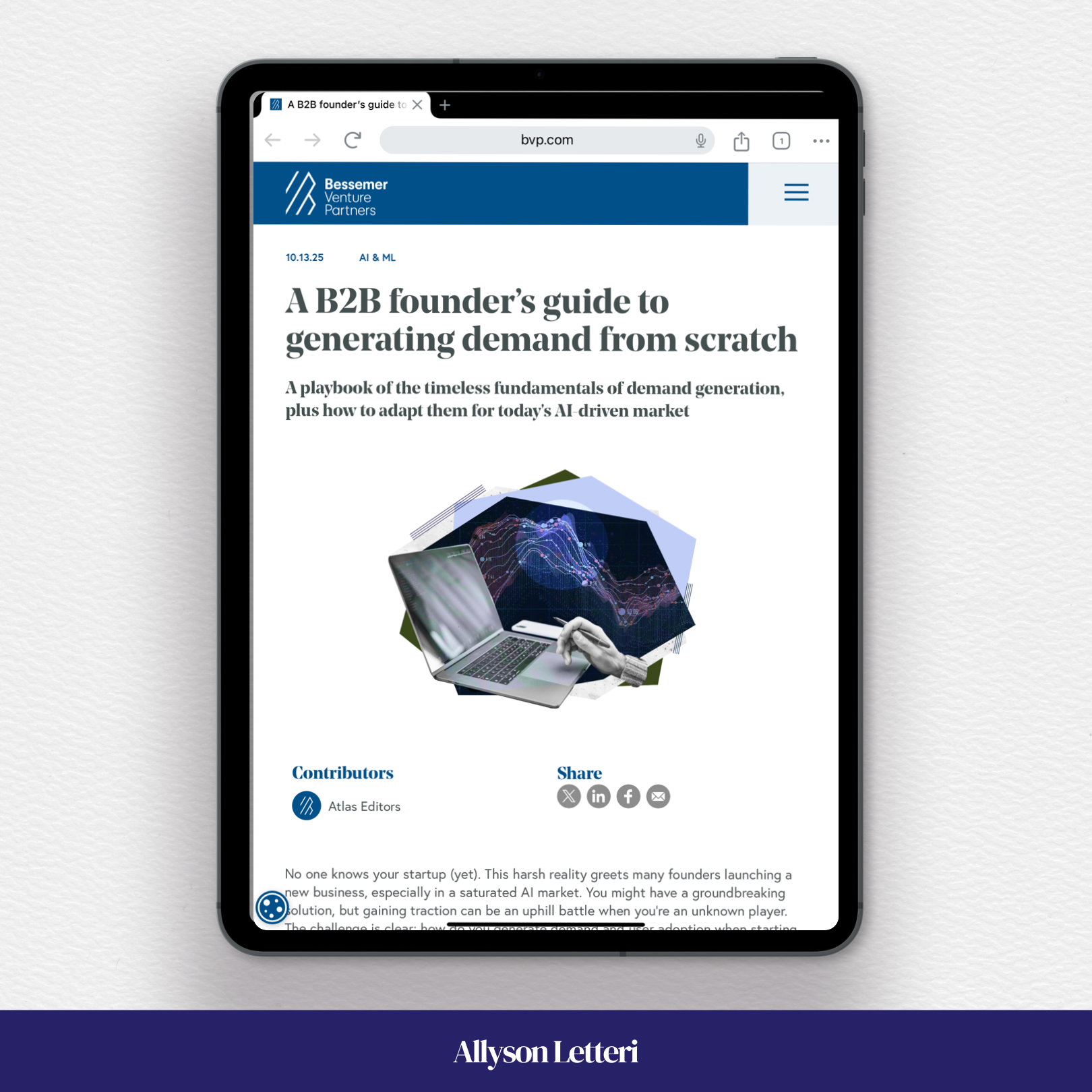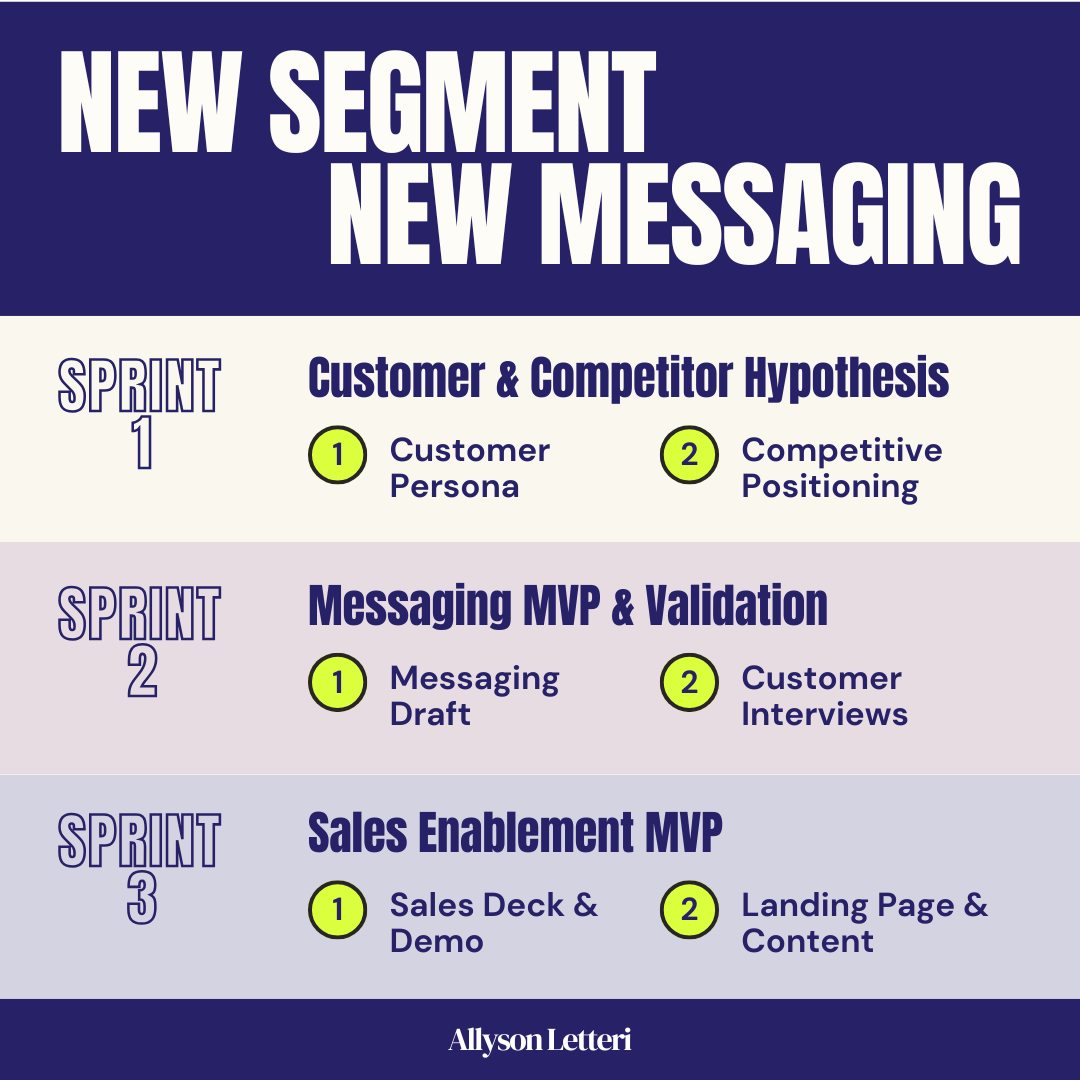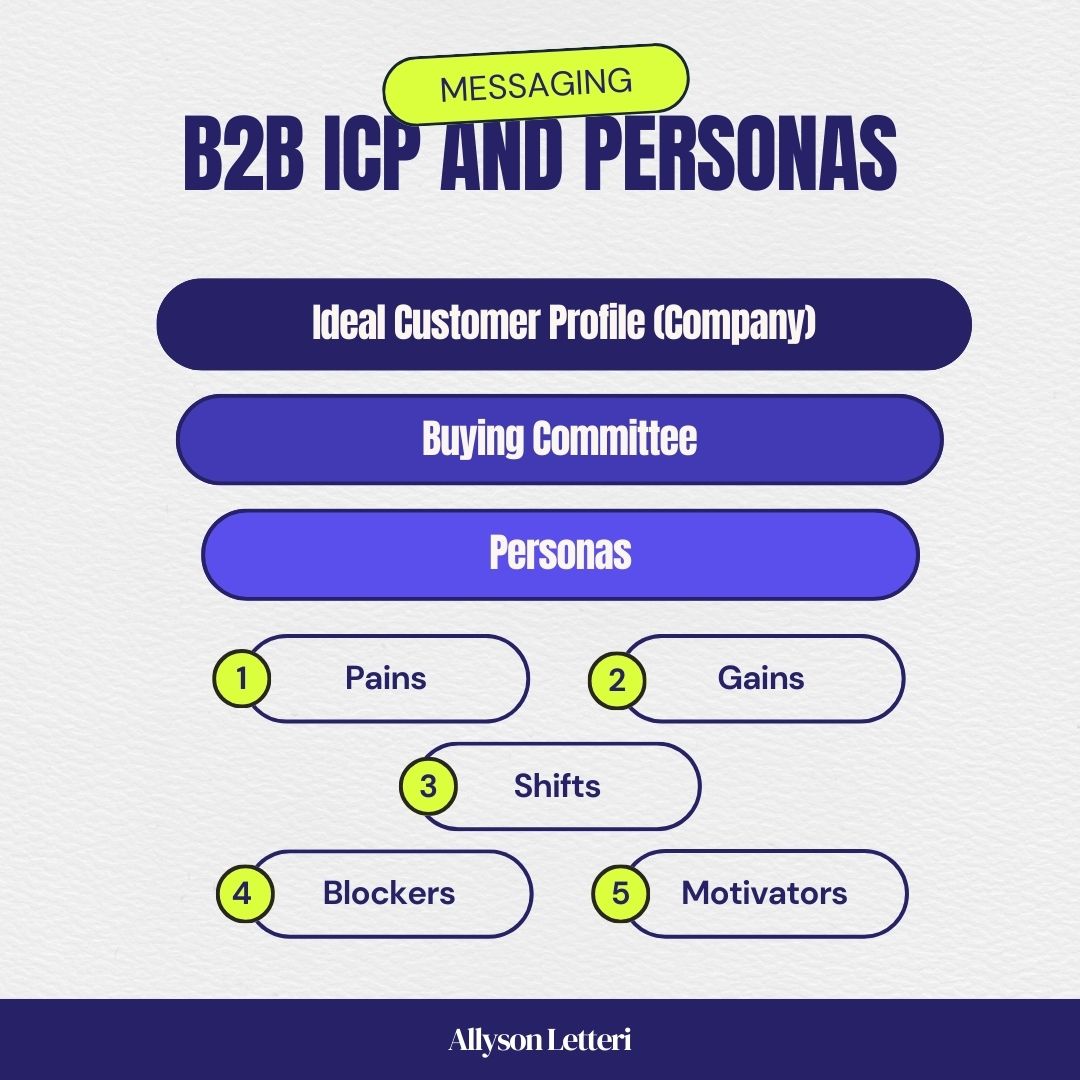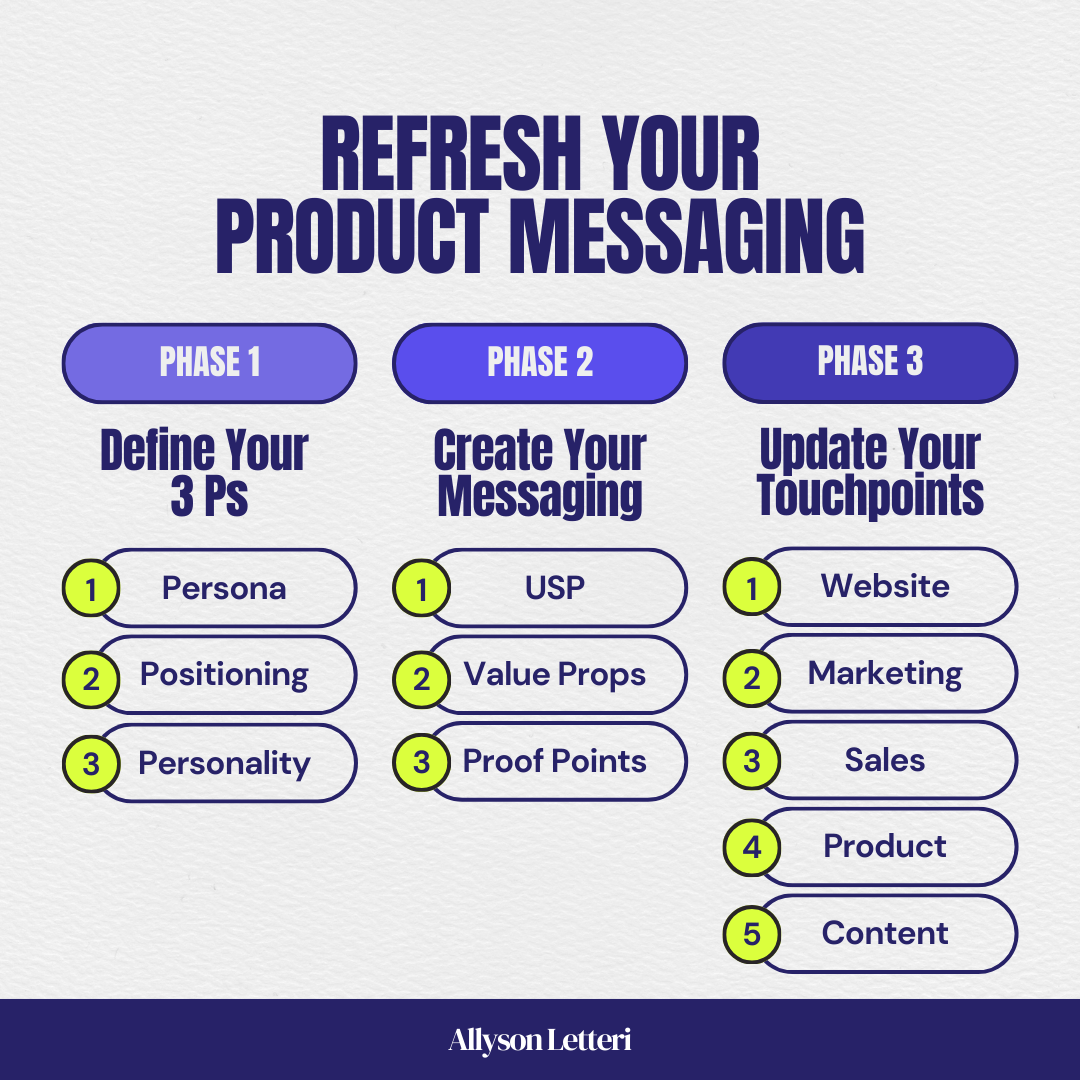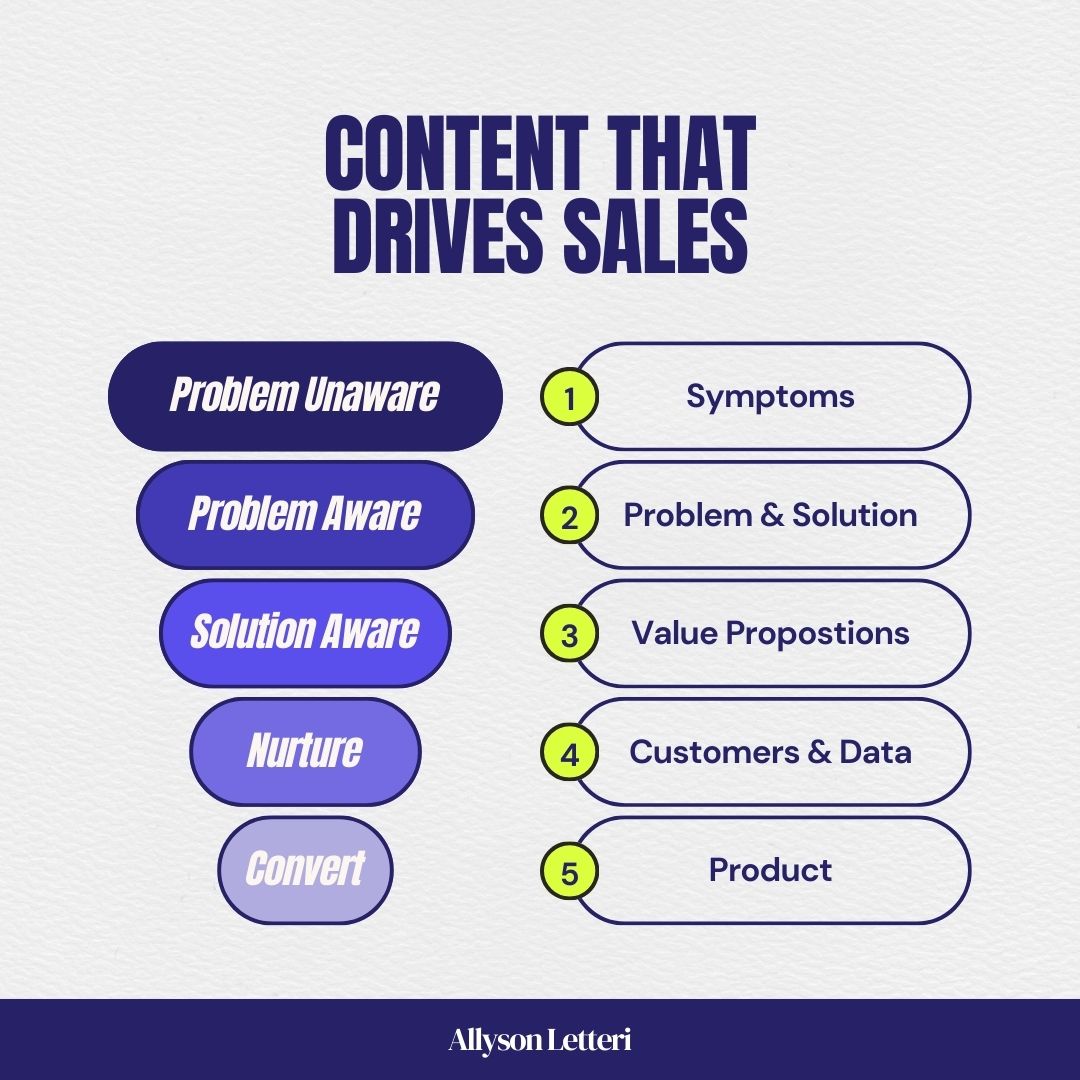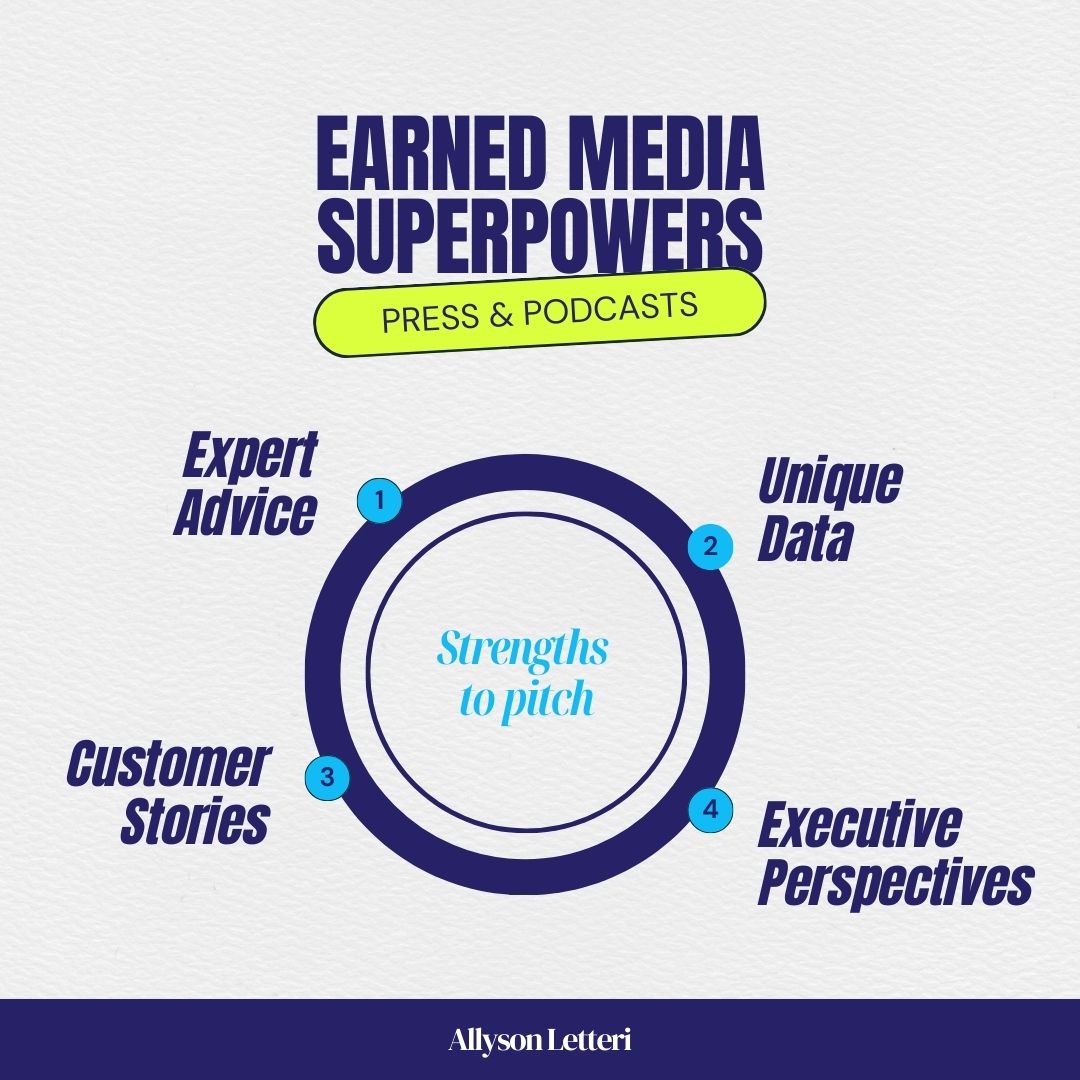A FOUNDER ASKED:
“What’s the best way to update our messaging? Our product has changed a lot, and now our website and sales materials are outdated.”
LEAD A MESSAGING REFRESH
Effective messaging is at the root of effective marketing. Outdated product messaging can slow growth, confuse customers, and hold back sales. As your product evolves and you better understand your customers’ needs, your messaging needs to keep up.
Here’s a step-by-step framework to create messaging that attracts and converts your ideal customers.
Three Phases of a Messaging Refresh:
Three phases of a messaging refresh:
- Define Your 3 Ps: Persona, positioning, personality
- Create Your Messaging Framework: USP, value props, proof points
- Update Your Touchpoints: Website, sales, marketing, product, content
PHASE 1: DEFINE YOUR 3 P’S
Effective messaging answers key questions to attract the right customers and convince them to buy:
- Who is your product for?
- What problems does it solve?
- What results does it deliver?
- How is it different and better than other solutions?
- Why should customers trust that it works?
- Why should they buy now?
Defining your 3 Ps gives you the insights to answer these questions and develop messaging. They are:
- Persona: Who is your ideal customer, and what do they care about?
- Positioning: How is your product different and better than other solutions?
- Personality: What’s your brand identity and tone of voice?
1. Persona: Who Is Your Ideal Customer?
Your ideal customer persona represents the primary buyer at your best-fit customer company. Identify your persona using three layers:
- Ideal Customer Profile (Company): What types of companies benefit most from your product? Consider industry, size, revenue, and tech stack.
- Buying Committee: Who is involved in the decision to buy? Identify the primary buyer, influencers, decision makers, and end users.
- Primary Buyer: Who is your champion? What are their job title, responsibilities, main pain points, and desired results?
First, focus on developing messaging for your primary buyer. You’ll need this most urgently for sales outreach, website copy, and marketing materials.
Next, capture these five factors to understand what matters most to your persona:
- Pains: What challenges does your ideal customer face that your product solves?
- Gains: What results and outcomes do they need?
- Shifts: What changes and events make them open to a new solution?
- Blockers: What objections or concerns could stop them from buying?
- Motivators: What proof, stories, or information will help them say yes?
Understanding these aspects allows you to craft messaging that speaks directly to your prospect’s needs. You’ll be able to powerfully describe your product’s value.
2. Positioning: How Is Your Product Different and Better?
Positioning defines what differentiates your product from alternative solutions. Your goal: make it obvious why your ideal customer should choose your product over others.
Your first step is to map the competitive landscape:
- Who are your top competitors? Consider direct competitors, manual workarounds, and alternative solutions that customers use today.
- What draws customers to these options? Identify the strengths and key selling points of these competing solutions.
Then, define your most compelling differentiators:
- How does your product deliver superior results?
- What benefits make your product unique?
- What capabilities give your product a competitive edge?
Your differentiators should be: ✅ Unique: They position your product clearly against competitors. ✅ Valuable: They solve urgent problems for your ideal customers.
Strong positioning makes it easy for customers to see why your solution is their best choice.
3. Personality: What’s Your Brand Identity and Tone of Voice?
Your brand’s personality shapes how customers perceive and connect with your product. A distinct voice helps differentiate your brand and build trust.
Consider these key questions:
- How do you want your brand to feel? (Supportive, inspiring, authoritative?)
- What tone will resonate most with your audience? (Casual, professional, bold?)
- How can your brand stand out through language and style?
Before writing messaging, define your tone of voice. Will you communicate in an energetic and motivational tone? Data-driven and analytical? Playful and friendly?
Brand archetypes are a fantastic tool for developing a winning brand personality. (More details to come in an upcoming post.)
A consistent brand and tone of voice ensure that your messaging feels cohesive and recognizable. A compelling brand also helps you stand out from other solutions.
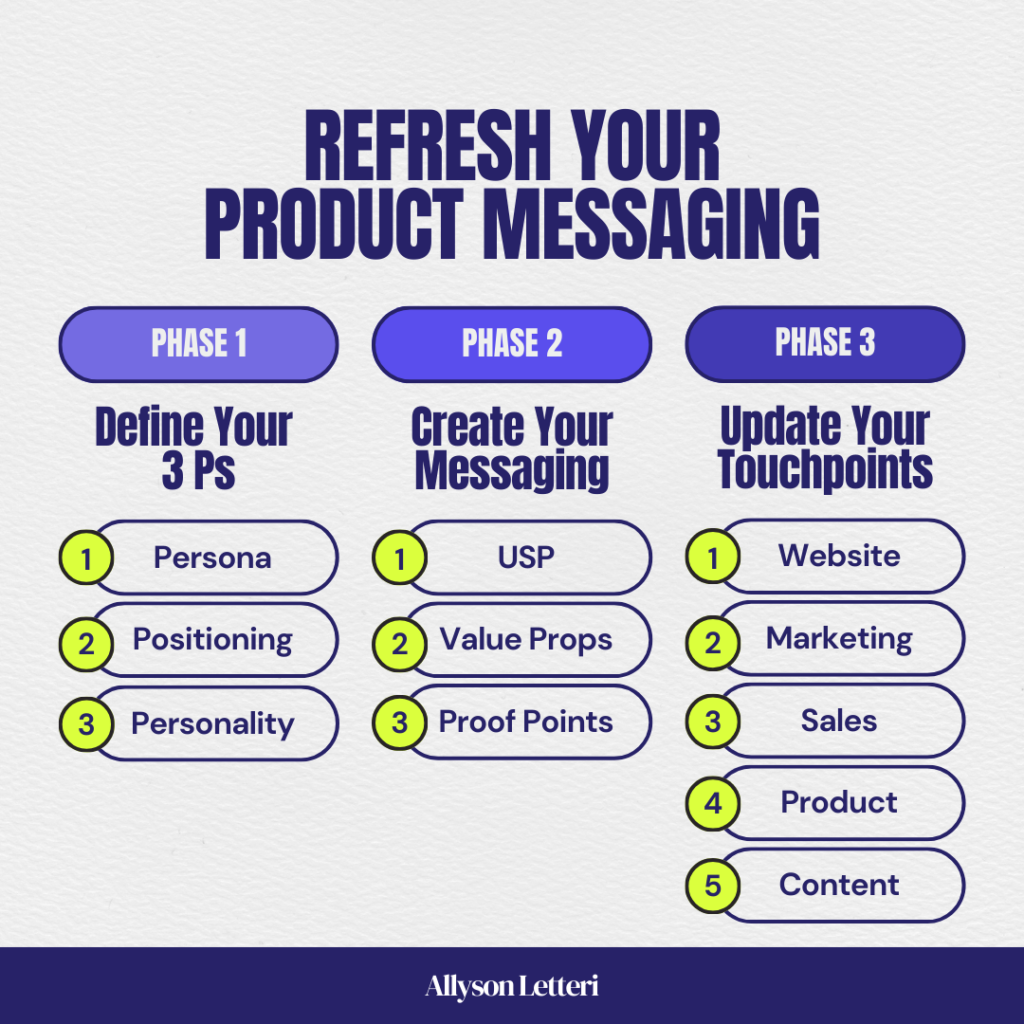
PHASE 2: CREATE A MESSAGING FRAMEWORK
Once you’ve defined your persona, positioning, and personality, it’s time to build a messaging framework. This framework serves as a wireframe for your homepage, sales deck, and other marketing materials.
1. Unique Selling Proposition (USP)
Your USP is a short, compelling statement that explains:
- What your product is (category)
- Who it’s for (ICP and persona)
- The #1 outcome it delivers
Here’s a USP formula:
[Product name] is a [what/category] for [who/ICP and persona] that delivers [#1 outcome].
Your USP will be front and center on your website, sales deck, and marketing materials. It’s also a crucial soundbite for media interviews, videos, and presentations.
2. Value Propositions
Identify the top three benefits customers get from using your product. Your value propositions answer the question: Why should customers choose your product?
Your value props should be:
✅ Benefit-oriented: Focus on results, not features. Start statements with an action verb (save, increase, enable) or descriptor (easy, fast, smart).
✅ Differentiated: Highlight the unique outcomes that your product delivers so it can stand out from competitors.
Example value propositions:
- Boost Efficiency: Automate repetitive tasks to save teams 10+ hours a week.
- Enhance Customer Experience: Deliver personalized support that keeps customers coming back.
- Make Smarter Decisions: Gain real-time insights with AI-powered analytics.
3. Proof Points
Proof points make your value proposition credible, reassuring customers that your product delivers the results you claim it does. Strong proof points include:
- Key Features: Capabilities that drive results.
- Customer Testimonials: Success stories in customers’ own words.
- Case Studies: Examples and measurable impact from real customers.
- Earned Media: Press coverage and podcast appearances.
- Endorsements: Awards, credentials, and analyst reports.
- Metrics: Data that proves your value propositions.
Effective proof points overcome objections and help customers feel confident to buy.
PHASE 3: LAUNCH ACROSS CUSTOMER TOUCHPOINTS
Finally, apply your refreshed messaging across marketing and sales materials. Here’s where to start:
- Homepage: Update the hero section with your USP, then showcase value propositions and proof points.
- Sales Deck: Update your slides and key sales materials to emphasize your up-to-date benefits and social proof.
- Press Narrative: Align PR pitches and talk tracks with your refreshed messaging.
- Email Sequences: Update outbound and nurture campaigns with your new value props.
- Content Strategy: Ensure blog posts, social media, and ads reinforce your updated messaging.
Consistent messaging across channels strengthens your brand and improves engagement.
REFRESH YOUR MESSAGING AND CONVERT MORE CUSTOMERS
Great messaging isn’t a one-time project—it’s an ongoing process. By defining your 3 Ps and building a messaging framework, you create a strong foundation for growth. This messaging will attract the right customers, differentiate your product, and increase conversion.
If your messaging feels outdated or unclear, now is the time to refine it. Create your new messaging framework, align your team, and roll it out across marketing, sales, and product. The result? More engaged prospects, sales, and user growth.
Want More Help?
Want a step-by-step guide with templates to make this process easier? Get my book, Standout Startup, and build a messaging framework that converts. Or reach out to learn about my 1:1 advising and workshops.
